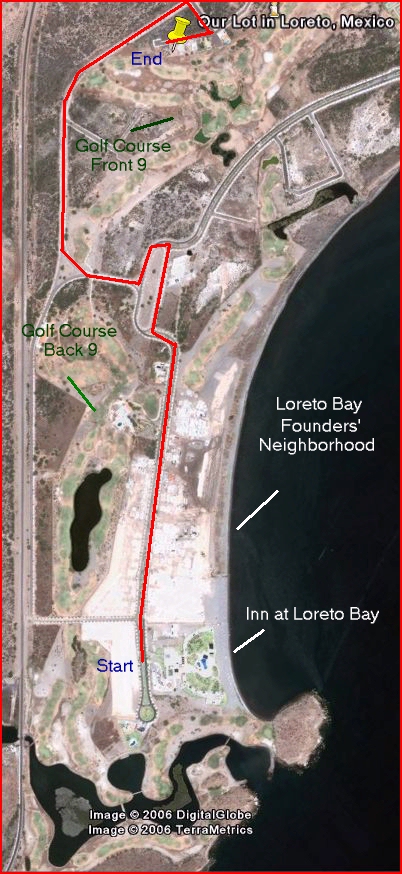May 28, 2007
Casa Brasil - full design now released!
Janelle has been working really hard these past three days and she has finished working on the H-house designs! This time she tackled all phases: from the first floor, through the second floor, all the way to the viewing tower. She just gave me the latest 2d drawings and 3d models which I publish below; since we have multiple versions of the design, we now append dates to the name, so this is the "2007-05-27 Casa Huna-Tillman H-House Design".
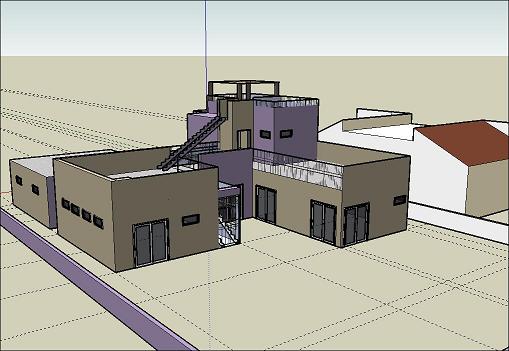
A 3d view of the house (all phases) from the golf course
with the neighboring house in the background
To view the 2d drawings
1) If you don�t already have it, click here to download and install the free Adobe Acrobat PDF reader.
2) Click here to view the first floor. This is what we call "phase 1" and is essentially what we will build at first.
3) Click here to view the second floor or click here for the viewing tower (to come at a later date).
To view the 3d models
1) If you don�t already have it, click here to download and install the free Google Sketchup v6.0 application.
2) Click here to view the 3d model of phase 1 (958 KB). Once you open the 3d model in Google Sketchup, click on the letter "o" (for "Orbit"). Now use your left mouse button and the wheel to move around the house (360 degrees!), zoom in or out, etc... For help and tutorials on Google Sketchup, see http://sketchup.google.com/support/.
3) Click here to view the 3d model of the full house (all phases, 959 KB).
Janelle has done a great job and we are both really happy with both phase 1 (the first floor) and the whole house. I personally think Janelle could easily have been an architect - these drawings and 3d models are simply amazing. Great job and congratulations Janelle!
Fast Internet connection in Loreto: Satellite service!
This article is a tip for anyone who's looking for a way to get fast Internet service in Loreto, Baja or anywhere in Mexico or North America. As Janelle and I prepare to build our house in Loreto, I wanted to make sure we had some way to communicate with our friend Thadius, who will be monitoring the construction.
A HughesNet satellite dish sits in our living room
Since we are renting a house, it would have been complicated to order high speed internet service in Loreto. The house currently doesn't have a phone, so even if our landlady would have agreed to it, it would have taken a long time (and would have cost a bundle) to get properly hooked up.
After a bit of research I found the solution: satellite Internet service from a company called HughesNet (www.HughesNet.com). We are currently getting 1.5 Mbps download and 200 Kbps upload in Nopolo, Loreto. That's plenty for browsing, email and even Vonage/Skype service!
See below for tips on how to order, pack and install a dish so you can get DSL speeds in Loreto or anywhere in Baja California.
Here are the steps I took to have a working high speed internet connection in Loreto, Baja California Sur (BCS), Mexico. Please note that prices, availability of service and speeds may vary - I am only providing this info for reference.
1) Step 1: Order HughesNet equipment and service
2) Step 2: Disassemble Dish
3) Step 3: Re-assemble Dish
4) Step 4: Install Dish and hook up modem
Below I provide more details and some pictures of the process.
Step 1: Order HughesNet equipment and service
The first step to get your Internet connection working is to order a HughesNet satellite dish, a tripod and a modem. You can purchase the equipment used on eBay (here's a sample search for "hughesnet dish"), but I chose to directly buy it from HughesNet. This way I got everything I needed: the dish, a tripod, the modem, a warranty on all equipment, and the monthly service. Click here to learn more and sign up.

The HughesNet pricing plans in May 2007
HughesNet will charge you for the installation when you activate a new account, so count on spending $299 to $399 to get started (they currently offer a $100 rebate). In addition the monthly service starts at $59.99/month for the basic plan (700 Kbps download, 128 Kbps upload). I chose the "Pro Plus" plan for an additional $20/month which gave us double the speed on the download (1.5 Mbps) and almost double on the upload (200 Kbps). A few notes:
- Due to the high latency in Satellite internet connections, there's a delay in Voice over IP services. When you speak it takes a few seconds for the other party to hear you, and sometimes the speech is broken up. That said, we signed up with Vonage (www.Vonage.com) so we can make and receive unlimited calls from anyone in the U.S for $24.99/month; considering the hundreds of dollars we'd need to spend on broken up cell phone calls, this is a great deal (more information on Vonage service below).
- HughesNet limits you to 370 MB of data per day. This is more than enough for regular browsing, email and even for Vonage phone calls, but if you start downloading or watching videos on YouTube.com, you may reach the limit. In this case, HughesNet will switch you to dial up speeds (56 Kbps). They call this the "Fair Access Policy" (FAP) - I guess it's fair for them.
Once you sign up, you'll get a call from your local US installer. I explained my situation and asked the installer to activate (or "provision") my modem so that I would simply be able to set it up in Baja. A couple of days later they delivered everything I needed: the satellite dish (assembled), the tripod (disassembled), a HughesNet modem, and 50 feet of double coaxial cable.
Step 2: Disassemble Dish
I need a way to get the dish and the rest of the equipment down to Loreto, so I chose to disassemble the Satellite dish so I could pack it up. Here are the detailed steps on how to disassemble it - click on any image to view a bigger picture.
You'll notice that I mounted the dish on its tripod using a couple of 2x4s. I was trying to test the dish and modem while I was still in the San Francisco bay area. Unfortunately that was a bad idea: after a week of trying to get a lock on the satellite, I gave up. I think that having it mounted on the 2x4s simply didn't give me any chance of setting up the correct angles; but it gave me plenty of experience in assembling the whole system, so I could write this article, so it wasn't all bad. ;-)
2.1 Here's the HughesNet satellite dish fully assembled (front)
2.2 The dish fully assembled again (back)
2.3 The last picture of the dish fully assembled (side)
2.4 The tools you'll need to assemble or disassemble the dish and tripod
2.5 I got this socket wrench kit at Home Depot for $19.99
2.6 You'll mostly be using a 1/2 inch socket, although sometimes the 3/4 is needed
2.7 Start by removing the three nuts from here
2.9 Now remove 4 nuts from the center piece
2.10 You'll end up with the piece responsible for the elevation separated from the dish
2.11 Next remove the 4 nuts that attach the back to the dish
2.12 From the front you'll see there are 5 nuts, but we'll take care of the 5th one at the bottom later
2.13 Here's what it should look like after the 4 nuts are removed
2.14 You can now turn the dish upside down and remove the metal circle from the center
2.15 Remove the two nuts that hold the LNB bracket
2.16 The dish and bracket will now be completely separated
2.17 Now remove the two nuts that hold the back piece
2.18 This what it looks like after they're removed
2.19 Use a screwdriver to remove the last nut
2.20 You're done! Here are all the pieces together.
2.21 Next let's disassemble the tripod
2.22 Remove these two nuts
2.23 Use a pair of pliers if needed
2.24 Here are all the tripod pieces when disassembled
I packed every single piece above across three different suitcases. I took the main dish to a UPS store and for $20 got it in a box with a bunch of bubble wrap around it. This box ended up being 64 linear inches (width + height + depth), which is over the maximum 62 linear inches allowed by Alaska Airlines, so we had to pay another $50 to take it with us. I declared everything at the Mexican customs and had no problems getting the Dish into Mexico.
Step 3: Re-assemble Dish
When you arrive in Mexico (or wherever you end up landing), simply follow the steps above backwards to rebuild the Dish. This is where you'll appreciate properly packing every piece in a towel or bubble wrap so it doesn't break during the trip.
Step 4: Install Dish and hook up modem
The last step is to properly mount the dish in the roof of your house and point it to the correct satellite. I spent a few hours trying this on my own, but had no luck. I didn't have the correct tools to mount the dish or to get a lock on the right satellite.
If you are in Baja Sur, I recommend "Los Frailes" who ended up installing and configuring the dish and modem for Thadius after we left. You can contact "Los Frailles" in the Baja Nomad forums (http://forums.bajanomad.com/), or shoot me an email if you can't find him.
Conclusion
In many ways we are pretty lucky we live in 2007 - the ability to get a fast internet connection almost anywhere in the world is pretty sweet. It allows us not only to email and talk to Thadius, but will also allow us to get full updates on the construction progress through pictures and videos he'll send us. Now let's get this house built!
Additonal notes on Vonage service
On the BajaNomad forums, regarding the Vonage phone service, someone asked: ""what kind of a delay do you get?" and "is this comparable to a land-line phone call? If not, what's the difference?". I thought I'd copy my answer below.
The answer will depend on your Internet connection:
1) I use Vonage as my main line in the San Francisco Bay Area. We have a cable modem connection with high download/upload speeds and low latency. So the call quality is extremely good - we don't see any difference comparing it to a land-line or cell phone call.
2) For the Vonage service using the HughesNet internet satellite, that's another story. There's plenty of bandwidth for Vonage (Hughesnet has 1.5 Mbps down/700 Kbps up, while Vonage only needs 90 Kbps). But the latency, or the time it takes for a "network packet" to go from point A to point B is very high (due to the Satellite connection).
So there will be 3-4 seconds of delay between the time I stop talking and my buddy hears me (or vice-versa). We now use the word "over" after we end a sentence, similar to hald-duplex radio protocols.
In addition the call will be clear to the person on the Loreto side (with the HN satellite connection), but can easily break up on the other side. This is due to the low upload speed which peaks at 200 Kbps, but sometimes can be much lower.
May 21, 2007
Spanish company set to invest almost $5 Billion US dollars in Loreto resort
Forbes (www.forbes.com) reports that a company based in Spain is set to invest 3.69 billion Euros ($4.97 billion US dollars) in a new resort in Loreto:
Fadesa to invest over 4.0 bln eur in tourist projects in Mexico - report 5/21/2007, LinkMADRID (Thomson Financial) - Fadesa Inmobiliaria SA plans to invest over 4 bln eur in four new luxury tourist projects in Mexico, El Economista reported, citing unnamed company sources.
According to El Economista, the largest of the four projects is a 3.695 bln eur investment in a resort in Loreto, Baja California, with a 7,000-room five star hotel and 6,500 luxury residences.
Wow, 7,000 rooms in a 5-start hotel AND 6,500 luxury residences! I wonder where the resort will be located and what the "luxury residences" will look like.
May 13, 2007
Loreto Airport: less than 2 hours from Los Angeles!
Janelle and I have been visiting Baja California for years. We've driven down from San Francisco all the way down to Todos Santos, but most of the time we flew.
The problem when flying down to Todos Santos is that not there's no local airport. You have to fly for 3.5 hours to Cabos and then drive for almost two hours on a very dangerous road.
If you are lucky not to hit a cow or donkey, someone might be trying to pass a slow truck on the two lane road heading directly towards you. The multiple white crosses you see on the side of the road are evidence of this danger.
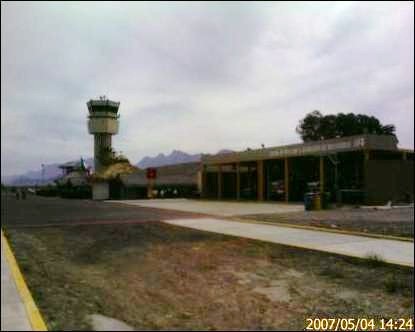
The Loreto airport with the firefighters in the foreground
For this reason we were really happy to know Loreto had its own International airport! In addition, the flight down from Los Angeles is less than 2 hours long!
There's also a great road from the airport to downtown Loreto or to Nopolo, where our lot is located. The trip from the airport to our lot takes less than 5 minutes. And to top it off, the road is lit: a series of poles illuminates the road allowing you to drive at night (something you'd never do in Todos Santos since the risk of hitting a cow would be too high).
Many folks in Todos Santos appreciate the fact that it's a bit harder to get there: it keeps the town from becoming a new Los Cabos. But Janelle and I both work fulltime and we don't have much vacation time. Being able to get to Loreto in a few hours instead of wasting a whole day when travelling is a big plus.
Below I copy some pictures I took of the Loreto airport and some satellite photos I've created using Google Earth.
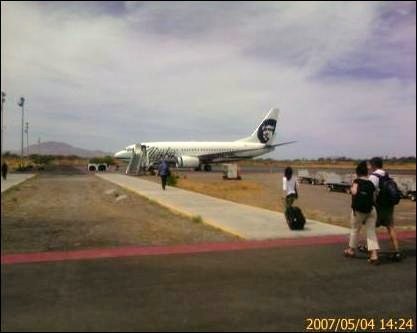
An Alaska airplane gets ready to take off from Loreto International (LTO)
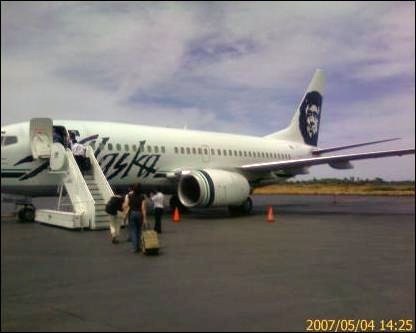
Passengers board an Alaska airplace at Loreto Internation (LTO). You can see Janelle with her leopard like carry-on
A satellite view of Loreto, the airport and Nopolo
A closer shot of the Loreto International airport (LTO). Notice that it's just south of downtown Loreto.
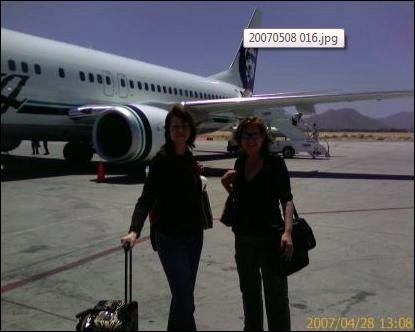
Janelle and Karen stand in front of an Alaska Airlines plane (in Cabos)
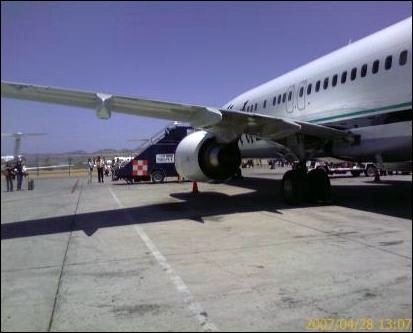
An Alaska Airlines airplane wing (at the Cabos, SJD, airport)
May 12, 2007
360 view of the lot, May 2007
Here's a 360 degrees view of our lot in Loreto, Baja California Sur (BCS), Mexico, as of May 3rd 2007:
The background music is a song called "We'll build a house", from the Israeli artist Aviv Gefen. Here's a quick translation of the song:
We'll build a house, Aviv GefenWe’ll build a house and live there
Rain will fall, it won’t be hot
And we’ll fall in love again from scratch (cool!)We’ll go on hikes with the kid
And we’ll get ourselves a doggie (yeah!)
We’ll cuddle up until the sun comes out (sweet!)We’ll both grow up and succeed (really?)
In the evening I’ll buy you a soda
In the morning we’ll then lock the doors so nobody breaks in (wow!)We’ll build a house and live there (all right!)…
Thanks to our friend Thadius who filmed the video. As the contruction starts he'll make similar videos so we can see the progress and compare to this shoot of the empty lot.
Latest Design - H-House
Janelle, George and Stacy have been working hard on the floor plans for many weeks. Due to our trip to Baja I didn't have time to post much, but we're now back and here are some Visio and CAD drawings.
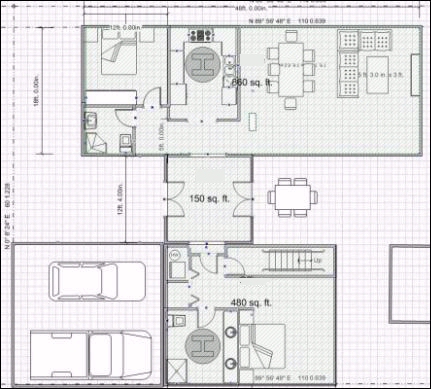
The first floor of the H-House, click here for larger image, or click here for its PDF
This is the floor plan of the first floor in a design I called the "H-House" (I say "H" is for "Huna", but Janelle's not sure that's right). Excluding the garage, this will also be our "first phase" of construction. Later we will work on the second and maybe even third phases, which will include the second floor, the pool, a viewing tower, the garage, landscaping, etc...
Loreto Bay Founders' Neighborhood, Nopolo, Mexico (May 2007)
This is a 5 minute video that we shot in May 2007 while we drove around the Founders' neighborhood of Loreto Bay:
During the video we stop for a few seconds while I zoom in on some marketing material Loreto Bay has displayed at the entrance of the golf course.
The song that you hear during the video is the "Girl from Ipanema", probably the most well known Brazilian Bossa Nova song, from Antonio Carlos Jobim. Click here to learn more about this amazing composer, arranger, singer, and pianist/guitarist who was basically the father of Brazilian Jazz (Bossa Nova).
May 9, 2007
CitiGroup investment on Loreto Bay: part of a bigger (green) strategy
Back in January I posted an article announcing that CitiGroup had become an investor in the Loreto Bay project (click here for details). Janelle yesterday sent me a link to an article from businesswire.com that explains some of the reasons for this hook-up:
Citi Targets $50 Billion over 10 Years to Address Global Climate Change
May 08, 2007, Businesswire.com, LinkNEW YORK--(BUSINESS WIRE)--Citi today announced that it will direct $50 billion over the next 10 years to address global climate change through investments, financings and related activities to support the commercialization and growth of alternative energy and clean technology among the clients and markets it serves, as well as within its own businesses and operations.
[...] Various businesses at Citi Alternative Investments (CAI) have been active in making environmentally friendly investments. For example, as part of the Sustainable Development Investment Program, CVC International has invested $150 million to date, including such notable transactions as Suzlon Wind Energy, a wind turbine manufacturer based in India, and Sindicatum Carbon Capital, a developer of projects that reduce GHG emissions globally. Citi Property Investors (CPI) invests in sustainable building projects.
Its first such investment was in the Loreto Bay Company, a 5,000-home community in Baja California, Mexico that is one of the largest sustainable resort communities in North America.
Interesting! Of course the idea of "sustainable communities" is a big selling point for many in North America today and CitiGroup is in the business of making money. But regardless, we all work to make money, and it's great that Loreto Bay has a goal of being sustainable and that CitiGroup has a specific strategy of investing money in such projects.
I copy the full article below, it's interesting.
Citi Targets $50 Billion over 10 Years to Address Global Climate Change
Includes Significant Increases in Investment and Financing of Alternative Energy, Clean Technology, and Other Carbon-Emission Reduction Activities. Builds on Existing $10 Billion Climate Change Activities , Link
NEW YORK--(BUSINESS WIRE)--Citi today announced that it will direct $50 billion over the next 10 years to address global climate change through investments, financings and related activities to support the commercialization and growth of alternative energy and clean technology among the clients and markets it serves, as well as within its own businesses and operations.
The $50 billion target is a realistic estimate based on market-based activities and transactions with clients as well as energy saving, “green” projects within Citi’s own operations. This target includes nearly $10 billion in activities Citi has already undertaken to address climate change to date, and is the latest example of Citi’s ongoing efforts in the broader environmental arena, including investments to control its own environmental footprint, advice to clients on risks and opportunities, and policy engagement.
“With a presence in more than 100 countries, Citi holds a unique position within the global community. This informs our commitment to bring forward the best solutions for our clients, while also benefiting the people and the communities where we operate,” said Charles Prince, Chairman and CEO of Citi.
“One area where we believe we have this opportunity is on environmental and climate issues, which pose a significant challenge to the world, to the global economy, and to clients and require forceful action,” Prince said. “The comprehensive program we are announcing today is not a wish-list, but a realistic, achievable plan that serves a critical global need and responds to an emerging investment opportunity.”
Citi has long been active on environmental issues, as evidenced by its initial and ongoing leadership in the development of the Equator Principles, which established best practices for assessing and mitigating social and environmental risks in project finance. Citi has also called for the development of global and U.S. frameworks that will help reduce greenhouse gas (GHG) emissions, drive innovation and opportunity, bring clarity and certainty to the markets and achieve a level playing field.
“As a global leader in financial services, we recognize our responsibility to confront climate change and the importance of identifying and helping implement new solutions for our clients and our businesses. We will continue to partner with environmental experts and clients as we address this issue,” Prince said.
“This new initiative is an excellent complement to Citi’s call for stronger, market-based climate policy in the United States and abroad,” said Eileen Claussen, President of the Pew Center on Global Climate Change. “Citi understands how profoundly climate change will transform the economy, and they are pioneering opportunities for the capital markets to meet the climate challenge.”
Citi’s activities in the area of climate change span its entire business and operations. They include:
Corporate-Wide
Citi will increase ten-fold, to $10 billion, its commitment to reduce its corporate environmental footprint through its own real estate portfolio, procurement and energy use, as part of its pledge to reduce GHG emissions by 10% by 2011. This ambitious undertaking across Citi’s more than 14,500 global facilities is driven by the creation of a Global Energy Council; purchase of 52,283 MWh of green power for operations; and its goal of achieving environmental certification (e.g. Leadership in Energy and Environmental Design or LEED in the U.S.) for the construction of all new office buildings and operations centers and evaluation of existing larger facilities.
In 2007, two major U.S. office facilities in Dallas and New York City are in the process of achieving LEED status, with a new office tower in Long Island City, NY, housing 1,500 employees, achieving LEED Silver rating, and a data center in Europe that is being designed to achieve LEED Gold status. Citi expects to open LEED-certified retail branches in 2008, and has already begun installation of 100% recycled materials.
Citi Markets & Banking
Citi’s Markets & Banking group plans to invest in and finance over $31 billion in clean energy and alternative technology over the next ten years through the expansion of existing activities and the launch of new client services. With committed investments and financings approaching $7.5 billion to date, the Markets & Banking group sees tremendous opportunities to support companies working in alternative energies such as solar, wind, hydro and geothermal; helping to commercialize energy efficiency ideas; and facilitating investments in aging infrastructure using clean and efficient technologies.
Citi has a growing portfolio of equity investments in renewable energy projects, including wind farms in Minnesota and New Mexico. Citi recently advised and financed the $2.15 billion acquisition of a major US wind portfolio by EDP - Energias de Portugal that plans to bring over 9,000 MW of new wind development projects to market. Citi also underwrote US Green Bonds for a green/carbon neutral real-estate development in Syracuse, NY, and will continue developing innovative financial products to support clients as they implement climate change initiatives.
Since 2006, Citi has also provided advisory services in targeted GHG-intensive sectors to help clients analyze and understand carbon exposure and reduction strategies, building on Citi’s industry leading environmental and social risk management (ESRM) capabilities.
Citi Alternative Investments
Various businesses at Citi Alternative Investments (CAI) have been active in making environmentally friendly investments. For example, as part of the Sustainable Development Investment Program, CVC International has invested $150 million to date, including such notable transactions as Suzlon Wind Energy, a wind turbine manufacturer based in India, and Sindicatum Carbon Capital, a developer of projects that reduce GHG emissions globally. Citi Property Investors (CPI) invests in sustainable building projects. Its first such investment was in the Loreto Bay Company, a 5,000-home community in Baja California, Mexico that is one of the largest sustainable resort communities in North America.
Underscoring Citi’s continued commitment to the environment, in April 2007, CAI created a standalone investment center called Sustainable Development Investments (SDI). SDI builds on Citi’s Sustainable Development Investment Program with an expected ten-fold increase in its capital commitment to over $2 billion of private equity over the next ten years in renewable and alternative energy, clean technologies, energy efficiency, carbon credit markets, waste and water management and sustainable forestry. Similarly, CPI intends to commit $500 million to investments in sustainable building projects over the next 10 years.
Global Consumer Group
Citi’s consumer franchise is offering climate friendly mortgage, card and commercial finance products to its clients. In the summer of 2006, CitiMortgage and Sharp Electronics Corporation, the world’s leading producer of solar cells and U.S. subsidiary of Sharp Corporation (Osaka, Japan), signed a joint marketing agreement that enables Sharp’s Solar Energy Solutions Group offer home equity loans and lines of credit through CitiMortgage as an additional financing option for homeowners to purchase and install solar electric systems. The home equity program offers customers an affordable alternative to make this energy-efficient upgrade to their homes.
Citi’s commercial finance and leasing division, CitiCapital, is more than doubling its commitment to facilitating the reduction of carbon-gas emissions and promoting sustainability by 2010. Its CitiCapital Energy Finance Unit has an existing portfolio of over $1 billion from underwriting energy efficiency upgrades for universities, local school districts and various municipalities in the United States, allowing clients to amortize the cost savings of improvement over a 15- to 20-year period generally without capital outlays.
In the workplace, Citi recently demonstrated its commitment to healthy work settings and environmental responsibility with its new Citi Cards facility in Elk Grove Village, Illinois, which was designed with numerous environmentally sustainable features.
In addition, Citi Community Development is building on its existing investing activities to include green-related investments, such as renewable energy tax credit investments and green private equity investments. And members of Citi’s popular “Thank you” points rewards program can redeem points for a range of environmentally responsible rewards.
Global Wealth Management
Citi Investment Research issued over 70 climate-related notes in 2006. A major thematic investment research report by Edward Kerschner, Chief Investment Officer of Citi Investment Research, highlights the investment opportunities and implications of a changing climate. Based on this report, Citi is holding a two-day conference on June 5-6, 2007, that will bring senior executives from the corporate, political, regulatory and advisory arenas together with influential global investors to discuss the issue.
Citi Smith Barney and Citi Private Bank also advise clients on opportunities in the socially responsible investment arena, including climate-friendly opportunities.
Citi Private Bank and the Financial Times have created an Environmental Award for businesses from around the world that have significantly improved their environmental performance. The focus in 2007 is on GHG reductions, and the inaugural awards event will be held in London on September 19, 2007.
Additional Activities
Citibank, Citi Smith Barney, and Citi Cards now offer paperless statements to customers. For each client who elects to take advantage of this opportunity, a tree is planted.
Citi actively engages on the issue of climate change with stakeholders, including clients, employees and non-governmental organizations and socially responsible investors.
In 2006, the Citi Foundation provided $2 million in grants for sustainable enterprise, including climate-related programs in alternative energy and sustainable forestry and agriculture, and expects to continue to develop and grow this portfolio. The Citi Foundation currently supports projects such as the Ecologic Development Fund, which works in Honduras and Panama to produce community-based carbon offsets via the reforestation of a reserve.
Citi endorses industry-wide efforts to advance climate solutions, and is actively involved with other corporations on climate change in such groups as Columbia University’s Global Roundtable on Climate Change (GROCC), the Pew Center on Global Climate Change’s Business Environmental Leadership Council, the 3C initiative led by Vattenfall, the World Resources Institute (WRI), and Renewable Energy and Energy Efficiency Program (REEEP).
Citi’s stock is part of Dow Jones Sustainability Index and FTSE4Good, both of which acknowledge leadership in setting standards in sustainable growth and in demonstrating exceptional environmental, social and economic performance.
Citi has been working with Sustainable Finance Ltd., leading advisors on sustainability opportunities to the financial sector, to develop and implement Citi’s environmental strategy, including the climate change commitments announced today.
Citi, the leading global financial services company, has some 200 million customer accounts and does business in more than 100 countries, providing consumers, corporations, governments and institutions with a broad range of financial products and services, including consumer banking and credit, corporate and investment banking, securities brokerage, and wealth management. Citi’s brand names include Citibank, CitiFinancial, Primerica, Citi Smith Barney and Banamex. Additional information may be found at www.citigroup.com or www.citi.com.
Certain statements in this document are "forward-looking statements" within the meaning of the Private Securities Litigation Reform Act. These statements are based on management's current expectations and are subject to uncertainty and changes in circumstances. Actual results may differ materially from those included in these statements due to a variety of factors. More information about these factors is contained in Citigroup's filings with the Securities and Exchange Commission.
May 7, 2007
Pictures of the "Mission Nuestra Senora de Loreto"
In our latest trip in May 2007, I took a few pictures of the "Mission Nuestra Senora de Loreto".
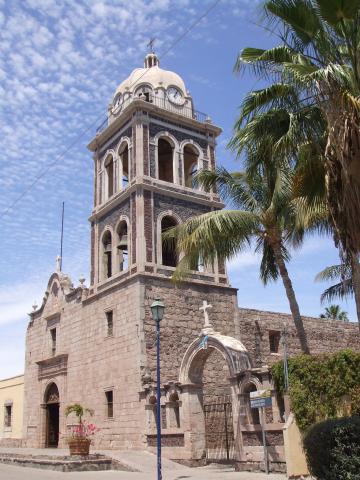
Mission Nuestra Senora de Loreto - founded over 300 years ago
Mission Loreto was founded on October 25, 1697 at the Monqui settlement of Conchó in the present city of Loreto, Baja California Sur, Mexico. Established by the Jesuit missionary Juan María de Salvatierra, this earliest successful mission in Baja California is sometimes considered "head and mother of all the Spanish missions in Upper and Lower California. Click here for another article I had published with more information on the mission.
In this trip I took 22 pictures of the Mission, its museum and the gift shops and streets around it. Click here to view these pictures (will open in another browser window).
3d views of our future home in Loreto
Our architects George and Stacy have given us a few drawings, including the two below.
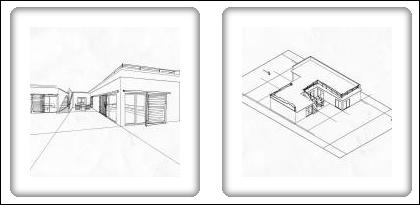
3d views of our future home in Loreto
These are amazing 3d views of what the house could look like once it's done. See below for larger versions and more details.
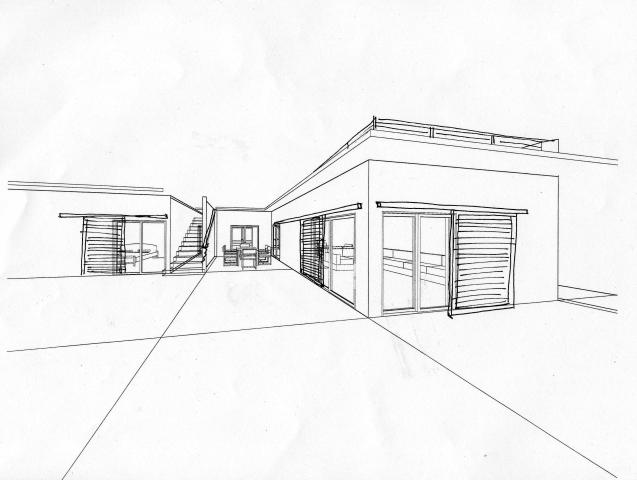
A view of the backyard from the gold course

A bird's eye view of the completed house (phase 1)
May 6, 2007
A drive through the Nopolo Neighborhood in Loreto, Mexico (May 2007)
We just came back from a trip to Baja California Sur (BCS) where, among many towns, we visited Loreto. This 6:40 minute video is a drive we took from the Inn at Loreto Bay to our lot in the Nopolo neighborhood:
Every time we come to Nopolo, I'm always amazed when I see the progress the Loreto Bay company has made since our last visit. Click here to watch a video of the same route that we filmed in September 2006. Also, below you can see a map of the route we took.
